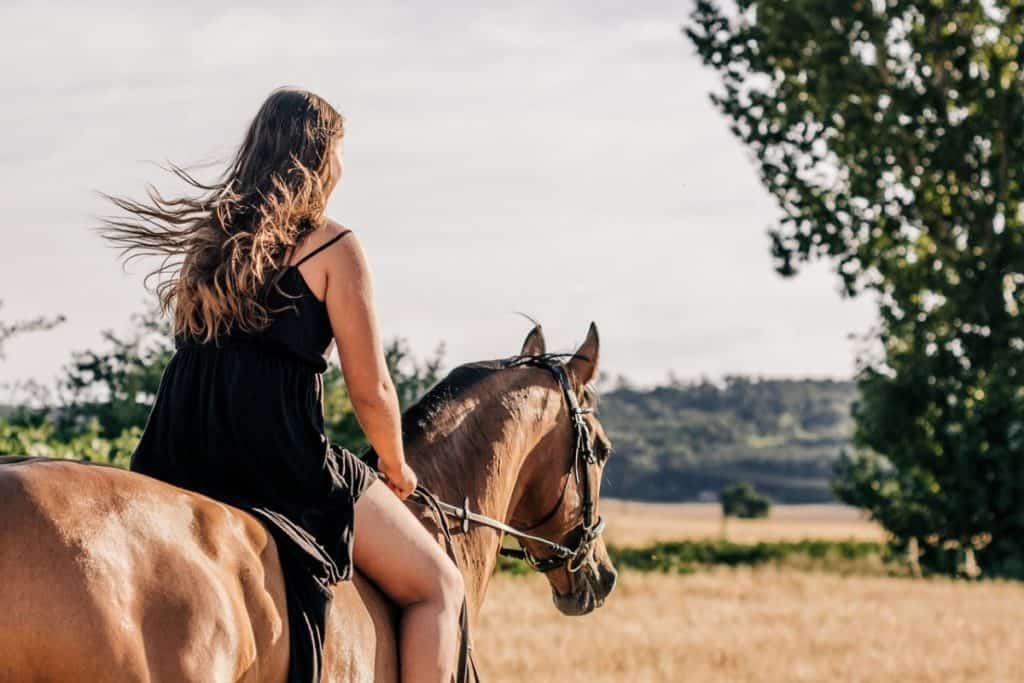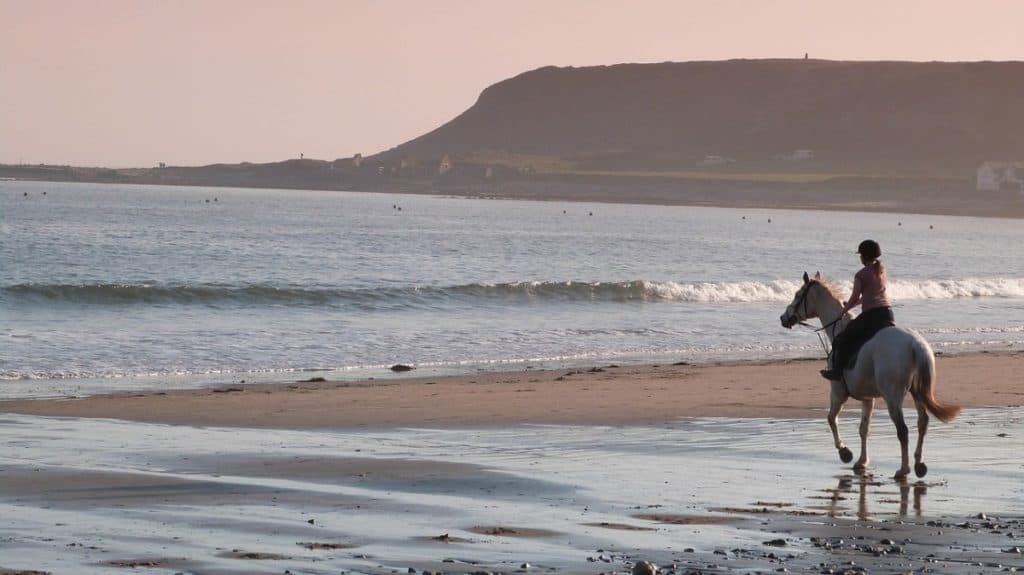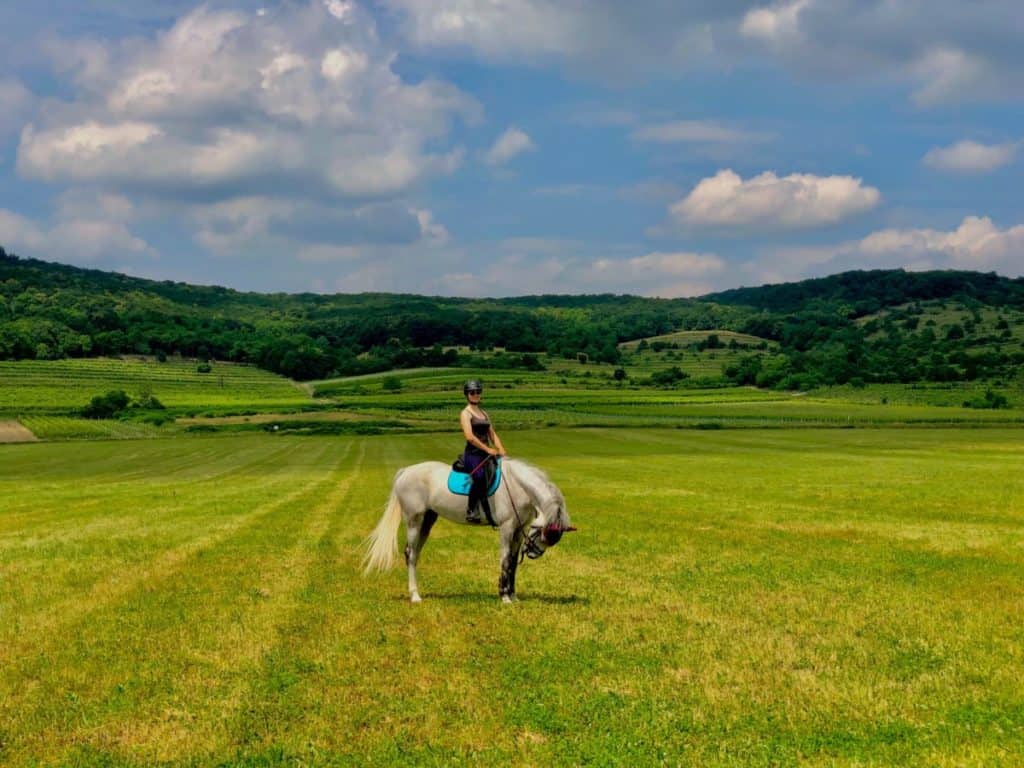
As the summer approaches and the sun spends less time hiding and more time sharing those rays and warming us up, our usual riding gear can get a bit restrictive and warm! So, what to do you do when the sweat gets a bit too real and you just want to peel those layers off?
Can you wear shorts horseback riding? Horseback riding in shorts is not recommended. Bare legs will rub against the leather saddle and chafe quickly and the skin is very likely to get pinched between the saddle and the stirrup leather. For the best protection and comfort, it is advised to wear long pants with some stretch. Most equestrians will wear breeches or jodhpurs when they ride.
Bubble burst. Shorts usually just aren’t the way to go in terms of wardrobe choice when going horseback riding. And we get it – it seems sooo tempting on those hot summer days, doesn’t it?
‘But she said usually. Does that mean there is a loophole here?’.
Very observant! I see you are committed to your lightly dressed horse riding dream.. So, let’s talk a little bit more about horse riding gear for those hot summer months.
Why are Shorts a Bad Choice for Horseback Riding?
Horseback riding requires the use of specific gear and clothing to ensure a rider’s safety and comfort. And although no one is going to arrest you for wearing shorts while riding, there are just certain guidelines you want to adhere to for your own sake. We have both tried and tested most clothing options on horseback and can report that shorts are definitely not a staple in our equestrian wardrobe.
When sitting in a saddle as the horse is moving, there is going to be friction between your skin and the saddle. But not only that, as your seat and legs inevitably move with the horse, your calves will run against the bottom of the saddle flap and your thighs and legs risk getting pinched in the stirrup leather. None of which are pleasant experiences and will likely ruin much of the horse riding experience.
Another thing that shorts don’t provide is grip. Breeches and jodhpurs most commonly worn by equestrians have sections on the inner thigh and leg wade of silicone, leather or other materials that provides a better grip in the saddle, which makes it easier to sit deeply and balanced on the horse.
Finally, leaving your legs bare also means you are completely exposed to the sun, which could cause sunburn. ‘Well, can’t I just wear SPF?’ you’re thinking, right? Well, not only with that create a highly slippery scenario where sweat and sun lotion merge to lubricate your legs and HELLO waterslide! Also, SPF can cause pretty nasty stains on the leather tack that can be difficult to remove. As someone currently looking to purchase a new saddle for my horse, I can tell you I’ll be guarding that thing with my life considering its breathtaking price point.
When Can You Wear Shorts Horseback Riding?
The only time we would probably give a nonchalant shrug to wearing shorts on horseback is if you are going bareback, swimming with your horse. Removing the tack removes most of the ‘rubbing factor’ and if you are going to get into the water, long breeches may not be the optimal choice of clothing. If you are now thinking, ‘can I really go swimming with a horse?’ then might want to check out our article on horses and swimming.
What to Wear Horseback Riding During Summer?
The two main challenges we encounter during summer is the heat and the sun. There are a few different ways we can adapt our clothing to remain as cool as possible and protect ourselves from the sun.
Wear moisture-wicking clothing. In the summer we sweat more and we want to move that moisture off our skin and the fabrics we wear. This is exactly what moisture-wicking materials do. They help us remain cool and dry even when panting under the unforgiving sun.
Chose lightweight materials. Materials such as microfibers are great for the summer as they are physically lighter and also dry very quickly.
Look for ventilation and breathability. Make sure that whenever a beautiful breeze is sent your way, you can benefit from its cooling touch because your clothing and helmet is well ventilated and lets the air pass through.
Wear lighter colors. Equestrian clothing often has dark colors, which is very practical when you are spending most of your time in an environment that isn’t exactly squeaky clean. However, in the summer black breeches will not be the best choice since darker colors will attract heat more easily.
Built-in SPF. Protecting our skin against sun damage is so important, and your clothing is an important factor in providing that protection. Just as SPF or Sun Protection Factor is the measure of how well a lotion or skin product protects against sun exposure, UPF or Ultraviolet Protection Factor is the measure of how well clothing does the same. The level of sun protection a garment provides depends on several factors such as color, construction, content, fit, UPF, coverage and activity. You can read more about UPF on the Skin Cancer Foundation’s website here. They also have a database of recommended clothes that have been given its Seal of Recommendation for sun protection.
Easy to wash and dry. Summer is hot and sticky which means we’ll have to wash gear and clothing more frequently. Make sure any new investments in this category are easy to wash and dry.
What do You Wear Horseback Riding on the Beach?

Horseback riding on the beach is one of those fairytale scenarios that I think all horse riders fantasize about from time to time (we certainly do when the rain and snow takes over the paddocks and we need to layer up like nobody’s business!). So, if you are one of the lucky ones and you are going riding on the beach, what should you wear?
Well, the answer is pretty much the same as you would wear normally horse riding in the summer. We’ll get into the specific items below, but essentially all summer riding gear principles apply, with the exception of if you are going swimming with your horse and you can opt for those shorts if you really want..
What to Look for When Buying Horseback Riding Gear for Summer

Before you go shopping for your summer gear, below are some recommended things to look for before so you can hopefully get the most appropriate and best-performing items for your hard-earned money.
Helmet
We always start with the helmet because it’s always the most important item on any gear list winter, summer, spring or fall.
- Ventilation is key in the summer so look for helmets with good and well-placed vents
- Visors will provide your face and eyes with some protection from the sun. Chose a model with a wider and longer visor than the traditional helmet.
- Moisture-wicking sweat bands in the front lining of the helmet will help clear up sweat from your forehead.
- Easily removable and washable padding
- Final tip: when trying on the helmet, bring your favorite sun glasses along to make sure you can wear both them comfortably.
Riding Pants
Aw pants, I have to wear pants?! Yes, you do, and this is what to look for in summer riding pants.
- Breathable, light materials that will help keep your body temperature down
- Moisture-wicking technology (just like for your helmet)
- UPF protection (minimum 30 is recommended by the Skin Cancer Foundation)
Shoes
Wearing the right shoes is so important and these should change with the seasons. Few things sound less appealing than riding in winter boots in summer. Melt alert!
- Height. In summer, peel off a layer on your legs and grab a pair of ankle boots. As long as they have a closed toe and a minimum 1-inch (2.5 cm) heel.
- Color. Stay away from black if you can.
The thing about the footwear you wear around horses is that they are meant to protect your feet from betting stomped on and thus needs to be a solid material. So, the ventilation and breathability options are unfortunately a bit limited in this category.
Gloves
Trying to slow down your horse when the reins keep slipping through your hands isn’t fun or safe. Gloves help your grip and can also protect your skin from the sun and blisters.
- Ventilation at the back of the glove will allow for some airflow.
- Color. Opt for a lighter color that holds less heat.
We hope this will help you feel cool and comfortable on the horse this summer. Have a great ride!
This article is accurate and true to the best of the author’s knowledge. It is not meant to substitute diagnosis, prognosis, treatment or any type of medical advice for humans or horses. Animals exhibiting signs and symptoms of distress should be seen by a veterinarian immediately.


